Books 25 Apr 2007 07:45 am
HOW-TO
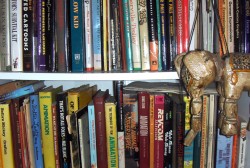 - We’re down to the nitty gritty with my book notes. There are so many books out there that it’s difficult to narrow down the books I like. I’ve talked about history of animation books; I’ve written about books out of print.
- We’re down to the nitty gritty with my book notes. There are so many books out there that it’s difficult to narrow down the books I like. I’ve talked about history of animation books; I’ve written about books out of print.
Today, I’d like to talk about HOW-TO books I like which are still available, and which I’d thoroughly recommend. By this, I mean books which tell how the nuts and bolts of animation are put together and that can get you inspired to do some hard work. None of these books are brand, spanking new; they’ve all weathered a bit of time and have proven themselves. They’re all still readily available, and I’ve given links.
- Dick Williams is an entity unto himself.
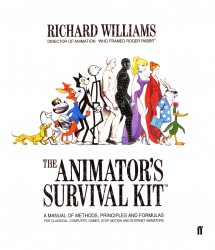 He was a dynamo in animation production for all those years he chose to make films. We all know about the legend of The Cobbler and the Thief and how the film was besmirched by the money lenders and takers. But the point behind Dick, it seems to me, is the people he inspired and the industry he rejuvenated single-handedly. For a while, thanks to the economic examples of Hanna-Barbera and Lou Scheimer, there was little good animation to be seen. The medium was in a desperate state with animators trying to imitate the horrible animation of the silent films of J.R.Bray when Dick Williams entered the scene and taught the world to love the work of the masters. He trained many animators to do great work, and he inspired hundreds of others.
He was a dynamo in animation production for all those years he chose to make films. We all know about the legend of The Cobbler and the Thief and how the film was besmirched by the money lenders and takers. But the point behind Dick, it seems to me, is the people he inspired and the industry he rejuvenated single-handedly. For a while, thanks to the economic examples of Hanna-Barbera and Lou Scheimer, there was little good animation to be seen. The medium was in a desperate state with animators trying to imitate the horrible animation of the silent films of J.R.Bray when Dick Williams entered the scene and taught the world to love the work of the masters. He trained many animators to do great work, and he inspired hundreds of others. 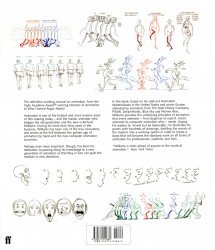
His legacy may be the book he developed which not only teaches, but it encourages and inspires.
Years ago, in the 70′s, the underground book that was passed around animaton was Dick’s lecture notes from the Art Babbitt lectures he’d hosted at his own studio in London. An ever-growing book of hundreds of xeroxed pages done in Dick’s own writing, the book took Dick’s own notes and made them useful to inbetweener trainees. (Somehow they seem more about how to inbetween than to animate.)
It’s obvious that Dick took these notes, cleaned them up and revised them to create his own book. And it’s excellent.
(The front and the back cover of the Williams book.
The back cover gives a good sample of what’s in it.)
In some ways, Dick’s book most reminds me of the Preston Blair book (see below).
It starts with basic principles of animation and movement and ultimately breaks into specific rules that have been developed over the years. The Blair book spends a lot of time trying to 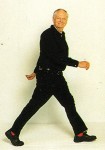 teach readers how to draw the traditional animation cartoon character. It does this prior to giving some real hard principles of animation layed out in a clear and simple way. The Williams book doesn’t spend as much time on the How-To-Draw part, but it does go into motion and has to be a gem for any neophyte animators out there.
teach readers how to draw the traditional animation cartoon character. It does this prior to giving some real hard principles of animation layed out in a clear and simple way. The Williams book doesn’t spend as much time on the How-To-Draw part, but it does go into motion and has to be a gem for any neophyte animators out there.
Get this book if you really want to know about animation, how things move and why. It’s a gem, and it doesn’t matter if you’re a 2D animator or a cgi animator. The principles are the same, and this book teaches you to respect those principles.
(Dick Williams always seems
to be walking in his photos.
.
The Williams studio in London created a British animation empire as well as a tradition that has thankfully slipped onto the rest of the world. A number of graduates of the Soho studio have developed their own world.
Tony White won the BAFTA award for his first solo Independent short, Hokusai. He eventually went into business for awhile and did some great commercial work.
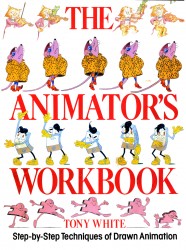 He also wrote and designed a brilliant book on animation, The Animator’s Workbook: Step-By-Step Techniques of Drawn Animation.
He also wrote and designed a brilliant book on animation, The Animator’s Workbook: Step-By-Step Techniques of Drawn Animation.
The book clearly and specifically gives lessons on animation and process. It’s attractively arranged and illustrated; the lessons are clear and certain; the information is supported by the experience of a gifted animator. I heartily recommend the book for the advanced animator as well as for the serious novice.
Tony has a second book which came out last year, Animation from Pencils to Pixels: Classical Techniques for the Digital Animator. I have to admit I haven’t purchased the book. An associate within my studio has a copy and says it’s much more complex in its layout and format. It comes with a dvd which illustrates the lessons in movement.
I have such respect for Tony and his work, that I’ll eventually buy the new book and will read it carefully. I can’t imagine his doing any better than he did with the first effor, but this gifted animator/director undoubtedly has a lot more to say, and I look forward to it.
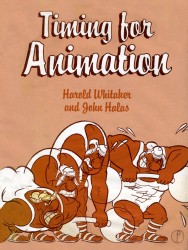 Another British animator whose book I’ve recommended several times in the past is Harold Whitaker. He was a gifted animator who worked at the Halas and Batchelor studio for many years, and he seems to have been the backbone of that studio in some of its later years.
Another British animator whose book I’ve recommended several times in the past is Harold Whitaker. He was a gifted animator who worked at the Halas and Batchelor studio for many years, and he seems to have been the backbone of that studio in some of its later years.
His book Timing For Animation has to be one of the finest books on 2D animation that I can recommend. I’ve said this on this site at least twice in the past – here and here – but I certainly have no compunction about plugging the book again.
I’ve posted the hardcover jacket but have linked to the paperback version. It’s a great book, and you should get it regardless of the version. I used to copy off pages as lesson-plans for the classes I taught at NYU. Go for it.
Finally, today, let me show you the book that started it all (not counting the 1920 Lutz book). Animator, Preston Blair, made himself famous among up-and-coming animators when he created an over- sized but slim, paperback book for the Walter T. Foster company. The book, Animation by Preston Blair, was designed to be sold in art stores and was featured at a very low price.
The book, over the years, has come in many different covers. For a while, they sold it at a higher price combining it with a slightly more advanced version done by Blair and retitling it to Cartoon Animation (The Collector’s Series).
It’s still the best bang for the buck.
Actually, you don’t even have to buy it. Go to ASIFA Hollywood Animation Archive and download a copy for yourself (print it out if you like.) I also suggest you follow the course they suggest in conjunction with John Kricfalusi. There’re a lot of interesting bloggers out there showing off their versions of Blair’s drawings/walk cycles and animation. You can’t help but learn from it. Start here and advance your way through it. The brilliance of the internet in action.
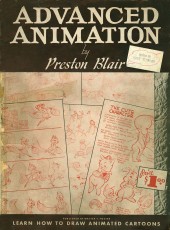
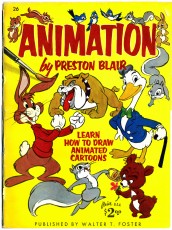
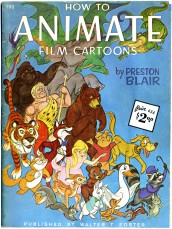

on 26 Apr 2007 at 9:25 pm 1.Mac said …
I love the Williams book, theres just so much information packed in there, really every page is important as the next. White’s book is also great but it’s been so long since I’ve looked at it, I got it when I was much younger before I could really take it all in. I’m going to have to check out Whitaker’s book, I’ve seen it around and been meaning to pick up a copy, definitely on my ‘to read” list. And how can you leave out Preston Blair when talking about animation books, another incredible book. These book posts are great!
on 26 Apr 2007 at 10:00 pm 2.Eddie Fitzgerald said …
An interesting article! If you have the time you should take a picture of your personal book shelf, containing books that have nothing to do with art or animation.
on 10 Mar 2016 at 2:08 pm 3.Dominika said …
Wow! You have an amazing collection of animation books. One in the photo particular interested me – “Revcom Television”.
Can you tell me the full name of this book. I was looking on the Internet, but I can’t find anyting about her.